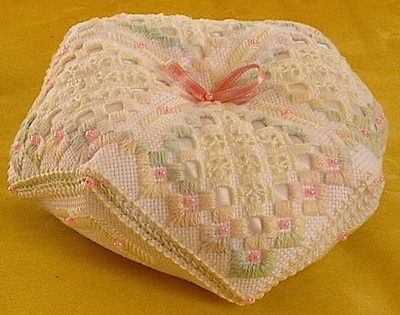Hardanger: how to begin
Date Added: 10/01/2009 Very often I receive some questions about the publications and the necessary materials for the hardanger, a very beautiful and particular embroidery technique.
Very often I receive some questions about the publications and the necessary materials for the hardanger, a very beautiful and particular embroidery technique.First of all, I must say that the hardanger is simpler than it seems. So, don't worry and just try because you will be satisfied.
It is necessary to be precise because you have to cut and unthread some parts. So it is important that the "blocks" are embroidered all in the right place or all will be wasted :)
However, it is a technique which will allow you to make important creations like the bords of your tablecloths or some centrepieces in a short time (it depends on the design, of course), but with a beautiful visual impact.
Day by day, more and more embroiderers got interested into this technique and today we have got plenty of publications and materials about it. Let's see something from this huge selection just to get a first impression.
Let's start with the publications: the unique problem is that there are some books in French, but images are really clear and the instructions are simple to follow.
- https://www.casacenina.com/catalog/product_info.php?products_id=46641 in Italian
- https://www.casacenina.com/catalog/product_info.php?products_id=39869 in French but with a lot of images.
- The following research page is fundamental in order to get some guides and images
Here are all the necessary material:
1) the hoop: it is complusory as you need to keep the fabric tight as you embroider on the unrevelled parts, in order to be precise with the blocks. We also suggest the use of the wooden little hoops (different diam.):
- https://www.casacenina.com/catalog/product_info.php?products_id=14513
- https://www.casacenina.com/catalog/product_info.php?products_id=5266 you can also use the qsnaps (even if the risk to get entangled with the unrevelled parts is high). Other roller hoops are not advisable

3) scissors: fundamental accessory like the hoop. It is necessary to use tiny and high pointed scissors because you will have to cut the fabric really close to the already embroidered parts. There are several advisable scissors like:
- https://www.casacenina.com/catalog/product_info.php?products_id=47844
- https://www.casacenina.com/catalog/product_info.php?products_id=44622
- https://www.casacenina.com/catalog/product_info.php?products_id=21684
- https://www.casacenina.com/catalog/product_info.php?products_id=22979
- https://www.casacenina.com/catalog/product_info.php?products_id=22981
- https://www.casacenina.com/catalog/product_info.php?products_id=22982
- https://www.casacenina.com/catalog/product_info.php?products_id=135
- https://www.casacenina.com/catalog/product_info.php?products_id=134
- https://www.casacenina.com/catalog/schede_stoffe.php?categoria=464
- https://www.casacenina.com/catalog/schede_stoffe.php?categoria=1172
- https://www.casacenina.com/catalog/schede_stoffe.php?categoria=362
- https://www.casacenina.com/catalog/product_info.php?products_id=39562
- and 28 ct cotton fabrics
5) the threads: we can use the perlé 5 (or equivalent) for the blocks and the entire points and perlé 8 (or equivalent) for the embroidery on the unravelled parts.
If you want to embroider on a 28ct fabric you have to scale up or down these dimensions and use the perlé 8 (or equivalent) for the blocks and the entire points and the 12 (or equivalent) for the unravelled parts.
for the perlé 5, 8 and 12:
- https://www.casacenina.com/catalog/schede_filati.php?categoria=249
- https://www.casacenina.com/catalog/schede_filati.php?categoria=250
- https://www.casacenina.com/catalog/schede_filati.php?categoria=574
- https://www.casacenina.com/catalog/schede_filati.php?categoria=170
- https://www.casacenina.com/catalog/schede_filati.php?categoria=421
- https://www.casacenina.com/catalog/schede_filati.php?categoria=422
And if you want you can free your fantasy with different threads:
These latter are especially used with 28ct linen.
Happy hardanger!
Cristina
Replies View ...

© Cenina S.r.l.
VAT : IT01651310516 - R.E.A. 128424
Fax: +39-0575-033115 - Tel: +39-0575-421407
E-Mail: [email protected]
VAT : IT01651310516 - R.E.A. 128424
Fax: +39-0575-033115 - Tel: +39-0575-421407
E-Mail: [email protected]

 English
English Français
Français Español
Español Italiano
Italiano